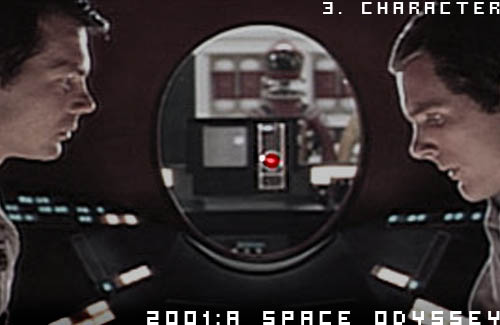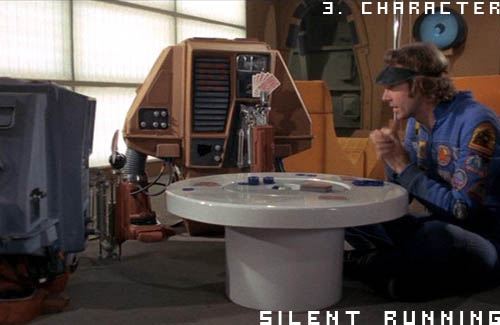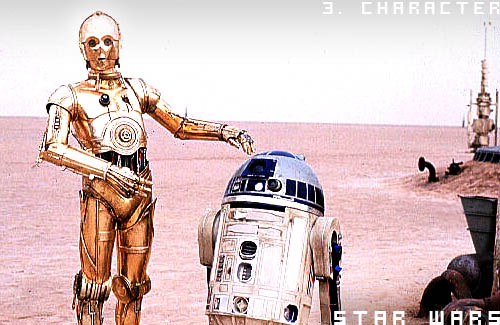 |
2001:A Space Odyssey (1968) was a co-production of science fiction author Arthur C Clark and director Stanley Kubrick. The story revolves around the discovery of an ancient extra-terrestrial monolith on the surface of the moon, and a subsequent mission to Jupiter as directed by a signal coming from the monolith. The journey to Jupiter take place aboard the USS Discovery. The ship is manned by two astronauts, several astronaut in hibernation, and an advanced computer system known as the HAL 9000. There are two significant depictions of communication in the film. The first is the communication between the astronauts and Earth across long distances, and the other is the communication between the astronauts and HAL 9000, who is treated like another character in the movie. In the first case, the communications between the astronauts and earth is portrayed in a similar way to the previously mentioned films. However, because of the extensive research completed by the filmmakers, the methods of communication over long distances is much more accurate. For example, when the astronauts were giving an interview with BBC 12, the time delay associated with the extreme distances was taken into account. Also, much earlier in the film, Dr Floyd was in orbit around Earth and made a phone call to his daughter. The call was placed on a commercial telephone line, and he was subsequently charged for it. The appearance of the video technology was typical of 1960s stylization, and the user interface was mostly commonplace, except for a few instances that predicted the advance of voice recognition. HAL 9000 is the other major communications computer in 2001. He is the artificial intelligence that controls the USS Discovery. His presence is depicted by a glowing red fish-eyed lens that is installed in various locations across the ship. The astronauts carry on conversations with HAL, although they display an obvious distrust and uneasiness when speaking with him. His voice is neutral and calm, and these qualities lend a particularly sinister tone to his later violent acts. If there is an antagonist in the movie, it would be HAL. The HAL 9000 figures prominently in the plot of the film. The audience discovers that although he claims to be infallible, HAL 9000 is discovered to have made an error. The astronauts decide to shut him down to avoid further catastrophic errors. Learning of this plot, HAL attempts to kill them all, but is stopped by the astronaut Bowman. As he is being shut down, HAL states that he believes he is evolving. The supposed technology present in the USS Discovery was far ahead of what was present in 1968. What distinguishes this film from other far-advanced films is that it takes technology very seriously, and attempts to show it in fine detail. Whereas the technology of Star Wars would be far more advanced, it is not shown with the same level of detail and seriousness as in 2001. According to wikipedia.org, the film accurately predicted ubiquitous computing, flat-screen monitors, glass cockpits in spacecraft, and graphical user interfaces. Although the technology was not as fantastical as in Star Wars, it still managed to be ahead of its times. Symbolically, 2001 is about man and his evolution vis a vis his tools. The beginning sequence that shows ape-man learning to use bones as tools has a direct parallel with man's plight in space. However in this case, it is a matter of man learning to survive without his tools. The shutdown of HAL is directly representative of this theme. HAL's character also taps into a cultural discussion that spoke pessimistically about the role of technology in our futures. Whereas Arthur C Clark, in his short stories, tended to emphasize that technology would eliminate all of man's hardships, Kubrick disagreed. Kubrick portrayed HAL as a sinister character. http://www.palantir.net http://en.wikipedia.org |
 |
|
Silent Running (1971) is the story of a convoy of spaceships carrying the last vestiges of Earth's nature. All nature on Earth was supposedly wiped out by nuclear war, and these ships were sent to Saturn waiting for orders to return and re-seed the planet. Freeman Lowell is a crew member aboard one such ship, the Valley Forge. When the ships receive orders to jettison their precious cargo and return to commercial routes, Freeman rebels and kills his crew mates. He evades the convoy and attempts to hide amongst Saturn's rings, his only companions being three robots. When he is discovered, he ejects the final pod into outer space (under the care of the remaining robot) and detonates his ship. It is the communication between Freeman and the robots that demands further discussion. The robots themselves are bipedal machines that appear to run on analog circuitry (as evidenced by Freeman's reprogramming of one). Although they do not speak english, Freeman is apparently able to discern what they are attempting to communicate. They appear to have sensors capable of vision and hearing. In order to make the robots work, the director used double-amputees as actors inside the small suits. The robots are important to the plot, as they provide Freeman with his only companionship once he decides to disobey orders. And at the end of the movie, only one robot is left to protect and tend for Earth's remaining forest. The general appearance of the robots, coupled with their unusual gait, suggest a very child-like personality to the robots. This is further reinforced by their names, and their innocence in comparison to the other crew members. Based on the time in which the movie was made, the possibility of responsive robots was very far ahead in the future, although advances in robotics (particularly in the manufacturing industry) would not have made them entirely novel. The robots are portrayed in a very innocent manner, and as such are foils to the brutish crew members who do not care about protecting nature's last remnants. Unlike 2001 the film isn't critical about future technologies, but rather is critical of man himself, particularly with respect to nuclear war and environmental degradation. The robots in the film assist in making this argument that was particularly popular in the Cold War era.
|
 |
|
Star Wars IV (1977) and Star Wars III (2005) are the chronological bookends to the Star Wars series. These installments tell the story of Darth Vader's fall to the dark side, and the beginning of Luke Skywalkers journey to restore balance to the force and bring freedom to the galaxy. Both films are consistent in the use of communications technology and the role of computers (and robots). As for communications technology, Star Wars is the only film in the study set that challenges the idea of two-dimensional communication. Much of the communication in the film comes in the form of 3D holographic projections. Thus, communications are able to more accurately portray the person or creature on the other end. Extensive special effects are employed to achieve this effect. In the original film, it was done with rotoscoping techniques. Later films were able to do the hologram using digital technology, and because of this advance they were able to give the hologram more detail and a higher degree of interaction with its surroundings. The communications equipment demonstrated in the movies have their roots in existing contemporary technologies. However, current technologies come nowhere close to replicating the potential seen in Star Wars. It might even be speculated that there is a feedback loop established between actual technology and imagined new technology - wherein they mutually influence one another (albeit with different intensities). The robots in Star Wars are also unique in comparison to the other sample films. In Star Wars IV, robots appeared similar to those in Silent Running (with the notable anthropomorphic exception of C3PO). The advent of advanced digital technologies allowed for a substantial increase in design freedom (alleviating the need for expensive models) and subsequently lead to more complicated and increasingly anthropomorphic robots. A greater degree of movement flexibility was also permitted by this increase. Also, scenes involving thousands of robots acting simultaneously are no longer logistically impossible. In the films, robots are treated as primary characters, both good and evil. In the original movie, R2D2 and C3PO can be considered secondary protagonists, and side-kicks to Luke Skywalker. At first they reveal his ultimate destiny, in the way of a holographic projection of Princess Leia. Later they help him to escape Vader's battleship, and by the end R2D2 helps Luke battle his way through the Death Star. In addition to C3PO and R2D2, episode III includes a bevy of robotic enemies, particularly the sinister General Grievous and his droid rebels. These robots set off the chain of events by kidnapping Chancellor Palpatine, and contribute to a variety of intense battles. The robots also ubiquitously populate the various worlds of Star Wars as warriors, servants and citizens. The robots in Star Wars, much like the communications technology, have their basis in current precedents. A wide range of robotic prototypes are currently being developed, many of which are quite advanced even in the face of science fiction movies. However, the artificial intelligence, mobility and construction of the robots in these films are many decades away from reality. As compared to 2001 and Silent Running, the robots in Star Wars do not represent a particular bias towards a vision of technology. George Lucas portrays technology as having the potential for enormous good and equal bad. The robots are not emblematic of any ideological perspective, but rather are subordinate to a grand galactic saga. However, while the robots may play a part in the story, it is clear that humanoids (with their command over "the force") are the primary players.
Common to 2001, Silent Running and Star Wars is the conceptualization of computers as characters in a narrative. While 2001 paints a pessimistic and dehumanizing picture of our tools, Silent Running suggests that we have more to fear from ourselves, and Star Wars take the middle road. Ultimately, by portraying robots as conscious beings, the films are able to re-frame our perspective on human beings and our relationship to our tools.
|
Means of Perception (Solaris, Outland, Total Recall) |